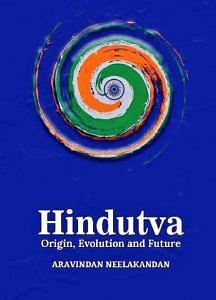
The Hindutva worldview—though not at its dominantly Vedantic-Buddhist and Vivekananda-Savarkarite conceptions—but at the level of its adherents and also at several middle level functionaries and activists, does have the problems of pseudoscience and of late, antiscience. While Hindutva is not a religious movement completely, yet religion is also a substantial part of Hindutva. Even though religion in India is qualitatively different on the whole from the dogmatic and purely faith as well as scripture-based religion, such religious components cannot be completely ruled out from the Indic religious phenomenon. So, such trends can be considered inevitable even when unwanted and harmful to the process of nation building—the process with which Hindutva identifies itself.
The following instances illustrate this.
In 2009 the Tamil Nadu branch of the Vishwa Hindu Parishad (VHP) launched its web TV. In one of its first webcasts, it claimed that a stone carving found at a village in Tamil Nadu which was claimed to be a ‘yantra’ dedicated to Shani, the deity of Saturn, resembles the design of the polar region of Saturn, the planet, that NASA’s Cassini spacecraft had photographed.
Anyone who goes through Hindu forums on the internet would be struck by similar claims which are totally baseless, unscientific and pseudoscientific. These claims often go viral with the ‘true believers’ spreading them in the digital networks including social media. NASA satellites stopping over a famous Siva temple in a village named Thirunallar in Tamil Nadu is another such example. Then we have the completely fantasy-based narrative about why a statue of Nataraja was installed at the European Organization for Nuclear Research (also known as CERN), which operates the world’s largest particle physics laboratory.
Also read:
This viral meme claims that the world faced the threat of apocalypse due to CERN’s experiment to discover the till-then-theorized Higgs boson, popularly known as the God Particle. Scientists around the world were terrified. Dr A. P. J. Abdul Kalam then came to the rescue and proposed that invoking Lord Nataraja would avert the wrath of the gods. So, the two-metre-high bronze statue symbolizing Siva’s cosmic dance of creation and destruction was installed. These memes get shared in thousands if not millions. The truth is that the statue was a 2004 gift from the Government of India four years before the experiment began. It was gifted to celebrate CERN’s long association with India, with no connection to the divine thwarting the destruction of the planet because of CERN experiments.
Then there is the persistent obsession with ancient flying machines and atomic weapons supposedly used in the events and wars of Hindu epics. A treatise on aeronautics attributed to the ancient sage Bharadwaj was apparently downloaded through ‘psychic channelling’ during the years 1918–1923, and since then Bharadwaj has been projected in much of the Hindu propaganda literature as the father of aeronautics.
All these have given the critics of Hindutva valuable ammunition to brand it as pseudoscientific and justifiably so.
Superficially, the juvenile need to find all modern scientific and technological achievements in ancient Hindu civilization and scriptures look very much like the theo-politically motivated pseudoscience of Intelligent Design (ID)/ Creationism, which denies evolution, that is very much a part of the Western right-wing package. However, there is a crucial difference.
Molecular biologist Paul F. Lurquin and anthropologist Linda Stone, in their 2007 work studying the response of scientists as well as varied human cultures to the science of evolution, point out the important difference between the encounter with science of the Western right-wing kind and Hindu nationalist kind, particularly in the context of National Democratic Alliance (NDA)-I (1998–2004). A negative bias against the Bharatiya Janata Party (BJP) permeates their book, which is expected given the staunch global propaganda against Hindutva as ‘Hindu fundamentalism’. Lurquin and Stone acknowledge that ‘the Rig Veda does not present its version of the creation of the universe as fact’, yet they point out that ‘there is the potential for Hinduism also to generate its own fundamentalism’. And they quote the BJP to be proof of the existence of such Hindu fundamentalism.
The BJP is an ultra-nationalist movement whose aim is to show and teach the ascendancy of all things Hindu, from history to science. In particular, the BJP advocates the development of ‘Vedic Science’ based on the posited scientific superiority of Hindu sacred traditions…Also, the BJP does not advocate ID or anything like it. The BJP has not singled out the theory of evolution as a threat to Hindu values. Hindu fundamentalism, then, is not interested in detracting science (including evolution) or proving it wrong but in integrating Vedic and Hindu traditions within the main body of science. This may reflect the enormous power of syncretism in Hinduism.
This is a significant difference. And in this difference lie the possibilities for the Hindutva movement to forge positive and healthy relations for the dialogue between science and cultural and philosophical traditions of India. And exactly this is what makes that space of Hindutva mainly on the internet and social media, inhabited by what we can call ‘cargo cult’ memes replacing serious dialogue with grotesque invention of fantasies that belittle both science and the umbrella of Indic philosophical traditions—a tragedy and serious threat to Hindutva as a nation-building process. This alternate aspect of Hindutva has been evolving through such pseudoscientific memes and claims accelerated by the internet and social media.
The original ‘cargo cults’ are symptoms of a deeper longing. The term originates from New Guinea, where waiting for ships or planes to bring dead ancestors and cargo began as a religious tradition in the 1910. The natives mimic the entire operation of radio communication of the planes with wooden replicas and await the arrival of the cargo as well as their promised leader. At first sight, the whole phenomenon looks juvenile and superstitious. Cultural anthropologist Marvin Harris (1927–2001), in an insightful study, pointed out that the cult actually carried within it a deeper criticism of global unequal distribution of wealth:
It is easy to dismiss cargo beliefs as the ravings of primitive minds: Prophet leaders are either consummate rogues preying upon the greed, ignorance, and gullibility of their brethren, or if sincere, they are psychopaths who spread their mad ideas about cargo through autohypnosis and mass hysteria. This would be a cogent theory if there were nothing mysterious about how industrial wealth gets manufactured and distributed. But in point of fact, it is not easy to explain why some countries are poor and others rich, nor is it easy to say why there are such sharp differences in the distribution of wealth within modern nations. What I’m suggesting is that there is really a cargo mystery, and that the natives are justified in trying to solve it….Without the cheapness of native labor and the appropriation of native lands, the colonial powers would never have gotten so rich. In one sense, therefore, the natives were entitled to the products of the industrialized nations even though they couldn’t pay for them. Cargo was their way of saying this. And that I believe, is its true secret.
The invention of the fantasy-filled stories like why the Nataraja statue was installed at CERN, connecting it with God Particle and protecting the world from annihilation, or the NASA Saturn yantra discovery, or the stopping of satellites by a mysterious ray above a particular temple, etc. are equivalents of the cargo cult. And the remarkable insight of Marvin Harris must be applied to this fringe yet significant movement within Hindutva in its encounter with science.
There is unquestionably a Hindu contribution to the generation of knowledge, and there is space for the dialogue for Vedic-Buddhist-Jain philosophical systems with the core questions that move the finest human minds towards probing the mysteries of the universe. But in the last seven decades, the institutions of the State have consistently denied any such healthy dialogue in the name of secularism. Radical left-wing propaganda, the Dravidian pseudo-rational movement, and so on, have either reduced the Hindu philosophy to the determinism of production relations or worse, to racial interpretations of the lowest kind.
 This excerpt from Aravindan Neelakandan’s Hindutva: Origin, Evolution and Future has been published with permission from Kali Imprint/BluOne Ink.
This excerpt from Aravindan Neelakandan’s Hindutva: Origin, Evolution and Future has been published with permission from Kali Imprint/BluOne Ink.

COMMENTS